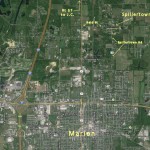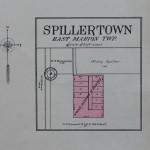Spillertown, a village in section 6 of East Marion Township, was incorporated March 3, 1900. The plat was surveyed for Noah Payne, dry goods merchant at Marion. A post office was opened May 20, 1898 with James F. Reid as postmaster. Except for an interim that fall, service was maintained until February 15, 1914.
 The old Harmony road went north from Marion through Spillertown to Frankfort and on to Benton in the days of horse drawn vehicles. This was the road the earliest settlers took to Garret’s tavern and then to Harmony, Indiana where the nearest carding machines were. Today the highway north from Marion leaves Spillertown to the east.
The old Harmony road went north from Marion through Spillertown to Frankfort and on to Benton in the days of horse drawn vehicles. This was the road the earliest settlers took to Garret’s tavern and then to Harmony, Indiana where the nearest carding machines were. Today the highway north from Marion leaves Spillertown to the east.
A landmark at Spillertown, the old Elijah N. Spiller homestead, was burned to the ground in September 1887. At the time the house was occupied by the pioneer’s daughter and her husband, Bethany J. and William M. Reid. Their daughter became the wife of Wiley F. Slater, county judge for several terms.
Elijah N. Spiller bought the land that became Spillertown in 1817 from its first settler, Richard Bankston. Mr. Bankston came about 1812, established ownership by occupation and by tomahawk right, then made a land entry in 1817. This preemption right and Mr. Bankston s improvements were sold to Mr. Spiller, who received the land patent from the government.
The home of Elijah N. Spiller was the meeting place in 1841 for the devout group who organized the first church of the Christian denomination in the county. Mrs. Joab Goodall rode horse back to these
meetings from her home southeast of Marion where Goodall’s bridge still crosses Crab Orchard. The younger Goodall children would take turns riding pillion behind their mother to these weekly meetings at the Spiller house. Churches of the denomination were organized throughout the county from that meager beginning, the church at Marion about 1843. The Spiller name recurs in almost every Christian church membership in the county. Members of the family aided Rev. Clark Braden in establishing the Southern Illinois college at Carbondale, conducted under the control of the Christian church after the Civil war and before the Normal was established.
Spillertown School, district 54, bears the impress of the family. Their standards established their school as a superior one, and to teach there has always been an acknowledgment of excellent qualifications.
Matthew I. Wroton taught Spillertown School in 1865, and for eight months he had as pupil Captain George W. Young, late of Company E, 30th Kentucky mounted infantry. Mr. Young went on to law school, opened an office in Marion, was county judge and states attorney. He returned to Spillertown for his bride, another daughter of Elijah N. Spiller.
Walter Williams of Herrin’s prairie taught his first school at Spillertown in 1881. He became a representative, and a further account of his services will be found in that section.
Four Spiller brothers came to the county in 1816 in a wagon train with other families from Robertson County, Tennessee. They were Elijah the preacher, Benjamin, Warrenton K., and William Spiller. Benjamin and William Spiller married in that earlier home Elizabeth and Winifred Benson, sisters of William Benson the first settler in Poor prairie who gave Williamson County the land for a county seat. Elijah N. Spiller was a son of Benjamin Spiller, and came with his father and uncles to establish his own home.
Benjamin and Warrenton K. Spiller were instructed to work their “hands” or hired men in Herrin’s prairie road district when the Franklin county commissioners’ court met during June 1839. Warrenton K. Spiller was judge of general elections in Crab Orchard precinct with polls at Bainbridge. He officiated at an election for county surveyor in 1838 and at the election on the question of a county division in 1839. Each time he was paid $1 for his services. When the division was accomplished, Warrenton K. Spiller was employed to copy the land records of Franklin County so far as they concerned Williamson county lands. He was paid $46 for that work.
The Spiller family scattered through the county until every neighborhood received the benefit of their leadership. For example, daughters of the family lived at Moeller crossroads and m Schoharie prairie. Another was a charter member of the Christian church organized in Stotlar School, and still another taught in that school until she became the bride of Hiram Stotlar.
(Extracted from Pioneer Folks and Places, Barbara Barr Hubbs, 1939, on sale at the Williamson County Museum)

